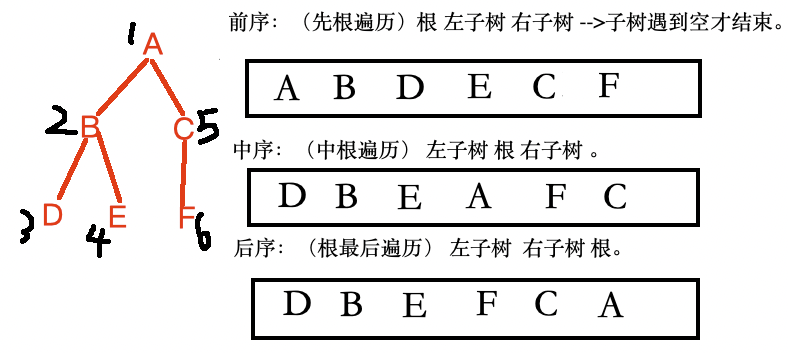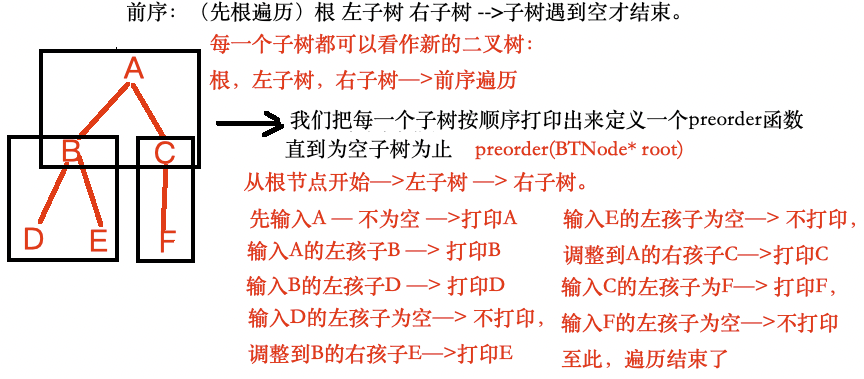数据结构自学Day9: 二叉树的遍历
一、二叉树的遍历
“遍历”就是按某种规则 依次访问树中的每个节点,确保 每个节点都被访问一次且只访问一次
遍历:前序 中序 后序(深度优先),层序(广度优先)
类型 | 遍历方法 | 特点 |
|---|---|---|
深度优先遍历 | 前序、中序、后序 | 类似“先走到尽头,再回头” |
广度优先遍历 | 层序遍历(Level-order) | 按层访问,从上到下 |
二、深度优先遍历
任何一个二叉数、都要看做3个部分:
1、根节点;2、左子树;3、右子树。
前序:(先根遍历)根 左子树 右子树 -->子树遇到空才结束,用途: 复制树、表达式树转前缀表达式等
中序:(中根遍历) 左子树 根 右子树 ,用途: 如果是二叉搜索树(BST),中序遍历输出的是升序序列
后序:(中根遍历) 左子树 右子树 根 ,用途: 删除树(先删子树再删根)、表达式树转后缀表达式等
示意图:

遍历方式 | 访问顺序 |
|---|---|
前序 | A B D E C F |
中序 | D B E A C F |
后序 | D E B F C A |
二叉树的前序遍历实现(利用递归的思想):

代码实现:
1、二叉树的初始化
#include<stdio.h> #include<stdlib.h> #include<assert.h> #include <string.h>#define Init_Capcity 5 typedef char BTDataType; typedef struct BNTreeNode {BTDataType _data;struct BNTreeNode* left_child;struct BNTreeNode* right_child; }BNTreeNode;BNTreeNode* BNTreeNode_Init(){BNTreeNode* pt = (BNTreeNode*)malloc(sizeof(BNTreeNode));pt ->left_child =NULL;pt->right_child = NULL;return pt; }
2、新增子节点
//新增子节点 BNTreeNode* BuyTreeNode(BTDataType val){BNTreeNode* NewNode = (BNTreeNode*)malloc(sizeof(BNTreeNode));NewNode->_data = val;NewNode->left_child = NULL;NewNode->right_child = NULL;return NewNode; }
3、二叉树的前序遍历以及主函数的实现
void BNTraverse(BNTreeNode* root){if(root == NULL){return;}printf("%c ",root->_data);BNTraverse(root->left_child);BNTraverse(root->right_child); }int main(){BNTreeNode* Root = BNTreeNode_Init();Root->_data = 'A';Root->left_child = BuyTreeNode('B');Root->right_child = BuyTreeNode('C');(Root->left_child)->left_child = BuyTreeNode('D');(Root->left_child)->right_child = BuyTreeNode('E');(Root->right_child)->left_child = BuyTreeNode('F');BNTraverse(Root); }
4、二叉树的中序,后序遍历
void InOrder(BNTreeNode* root){if(root == NULL){return;}InOrder(root->left_child);printf("%c ",root->_data);InOrder(root->right_child); } void PostOrder(BNTreeNode* root){if(root == NULL){return;}PostOrder(root->left_child);PostOrder(root->right_child);printf("%c ",root->_data); }
输出结果:
A B D NULL NULL E NULL NULL C F NULL NULL NULL
NULL D NULL B NULL E NULL A NULL F NULL C NULL
NULL NULL D NULL NULL E B NULL NULL F NULL C A
利用类似的递归思路求解,二叉树的元素个数,叶节点个数,深度等
1、二叉树元素的个数 -->遇到空节点停止
//两种方法 void TreeSize(BNTreeNode* root,int* psize){if(root == NULL){return;}//static int size = 0; //静态变量只有当前文件能使用(*psize)++;TreeSize(root->left_child,psize);TreeSize(root->right_child,psize); } //不需要额外参数 int TreeSize(BNTreeNode* root){if(root == NULL){return 0;}else{return 1+TreeSize(root->left_child)+TreeSize(root->right_child);} }
2、叶节点个数-->遍历到无子节点(叶节点)
//统计叶节点个数 int TreeLeafSize(BNTreeNode* root){if(root == NULL){return 0;}if(root->left_child == NULL && root->right_child == NULL){return 1;}return TreeLeafSize(root->left_child)+TreeLeafSize(root->right_child); }
3、需要比较左右子树的深度 -->遇到空节点停止
int TreeDepth(BNTreeNode* root) {if (root == NULL) {return 0;}int left_depth = TreeDepth(root->left_child);int right_depth = TreeDepth(root->right_child);return 1 + (left_depth > right_depth ? left_depth : right_depth); }
三、广度优先遍历(BFS / 层序遍历)
使用队列实现,按照“从上到下、从左到右”的层级顺序访问:堆的访问顺序
访问顺序: A → B → C → D → E → F
算法:
把根节点放入队列;
每次从队列中取出一个节点,访问它;
如果它有左子、右子节点,把它们加入队列;
循环直到队列为空。
等价于数组的访问顺序,我们直到其实堆就是按数组进行存放的
好了本期内容我们就到这里结束了!谢谢大家的点赞和收藏!
